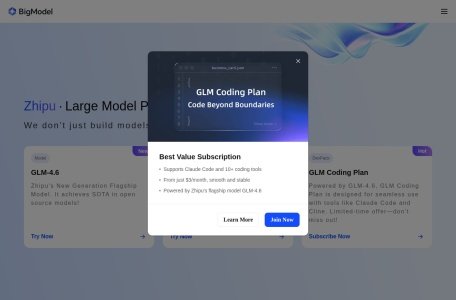
I. More Than an “LLM Library”: What Is BigModel?
When developers struggle with “complex APIs, insufficient computing power, and difficult customization” to integrate large language models (LLMs), or enterprises need to deploy AI in specialized fields like healthcare or law but lack tools for “domain-specific knowledge injection”—BigModel, launched by Zhipu AI, was built to solve these pain points.
BigModel isn’t just a single model—it’s a full-stack LLM development platform designed specifically for developers. Centered around Zhipu’s GLM series LLMs, it integrates four core modules: “model capabilities, development tools, knowledge bases, and deployment services.” This means developers don’t need to worry about underlying computing power or model training; with just a few lines of code, they can access industry-leading LLMs (such as GLM-4-long for 2 million-character long texts or CogVideoX for text-to-video generation). By 2024, nearly 1 million developers have used BigModel to build applications—from personal chatbots to enterprise-level intelligent customer service—turning ideas into real-world solutions quickly.
Crucially, BigModel lowers the “dual barriers” of LLM adoption: it offers 25 million free Tokens (available immediately after registration), and GLM-4-Flash is the first free LLM API, letting individual developers get started at zero cost. Additionally, its visual tools and detailed documentation make complex LLM capabilities (like multimodality or long-text processing) accessible even to non-AI specialists.
II. Core Capabilities: End-to-End Support from “LLM Calling” to “Scenario Deployment”
BigModel’s value lies not just in “providing LLM APIs,” but in building a complete toolchain covering “development, customization, deployment, and operations.” Its key features break down into three systems:
1. Full-Spectrum Model Matrix: Covering All Needs from “Text” to “Video”
Zhipu AI has opened its most powerful LLMs on BigModel, letting developers choose models flexibly without switching platforms:
- Text Interaction Core: GLM-4-Plus (flagship model for complex logical reasoning), GLM-4-Flash (free API for lightweight chat scenarios like intelligent Q&A bots), and GLM-4-long (supports 2 million-character long texts—ideal for document analysis, as it can parse entire e-books or legal contracts);
- Multimodal Capabilities: GLM-4V-Plus (visual LLM that recognizes image details and analyzes chart data, used for product quality inspection or medical imaging assistance) and CogView-3-Plus (text-to-image model with 4K output resolution, suitable for poster design or game asset creation);
- Text-to-Video Exclusive: CogVideoX (Zhipu’s first text-to-video model, generating 16:9 HD short videos. It turns “text scripts” into “dynamic footage” with one click, meeting needs for content creation or commercial ad production).
Each model comes with “scenario examples, API docs, and code snippets.” For instance, to generate a “tech product introduction video” with CogVideoX, developers only need to pass JSON parameters (including “shot descriptions and product keywords”)—a few lines of Python code trigger video generation, no complex video synthesis knowledge required.
2. Knowledge Bases & Customization Tools: Turn LLMs into “Industry Experts”
Generic LLMs often fail in specialized fields (healthcare, law) due to “outdated knowledge” or “vague responses.” BigModel’s “Knowledge Base Construction” feature solves this: developers can upload domain-specific expertise (e.g., a hospital’s case libraries, a law firm’s regulations, or a company’s product manuals) in bulk. Through “knowledge injection + model fine-tuning,” LLMs quickly master vertical-domain skills.
Take healthcare consulting as an example: a developer can upload a department’s guidelines for common disease diagnosis and medication rules. Using BigModel’s “one-click fine-tuning” (supports 10+ tool plugins, no manual fine-tuning code needed), GLM-4-Plus transforms from a “generic chat model” to a “specialized auxiliary diagnosis assistant.” It accurately identifies symptoms described by patients and provides clinically compliant advice (based on injected knowledge) instead of generic health tips.
3. Deployment & Operations: Flexible Options from “Cloud API” to “Private Deployment”
BigModel offers two deployment modes to balance “convenience” and “security” for different users:
- Cloud API Calling: Individual developers or SMBs don’t need to set up servers. After obtaining an API key, they can call models directly. The platform provides “key management + cost control tools”—developers can set API usage alerts and track Token consumption per request to avoid unexpected costs;
- Cloud Private Deployment: Enterprises handling sensitive data (finance, healthcare) can apply for dedicated computing power deployment. Models and data are stored on Zhipu’s exclusive cloud, with support for custom fine-tuning and permission control. For example, a bank can use BigModel for “customer loan application document analysis” via private deployment—all data stays within the enterprise, meeting regulatory requirements.
Additionally, the platform’s “Experience Center” is a “testing ground” for developers: no code required. They can test LLM features online (e.g., input long texts for GLM-4-long to summarize, or upload images for GLM-4V-Plus to analyze) and confirm results before official integration—greatly reducing trial-and-error costs.
III. From Sign-Up to Deployment: A 30-Minute Developer Onboarding Flow
BigModel’s core design principle is “simplicity for developers.” Even those new to LLMs can build applications quickly with these steps:
- Sign-Up & Initialization: Visit BigModel’s official website (bigmodel.cn), create an account, and complete verification to get 25 million free Tokens. Then create your first “project” in the console;
- Generate API Key: In the console’s “API Management” section, generate a dedicated API key (supports multiple keys for different applications). Keep the key secure—it’s used for authentication during calls;
- Model Selection & Learning: Choose a model based on your application (e.g., GLM-4-Flash for customer service, CogVideoX for video generation). Check the model’s “Development Docs,” which include full code examples (Python/Java) and parameter explanations (e.g., “temperature” or “max length” for text generation);
- Development & Debugging: Integrate the API into your application. For example, write a simple chat logic in Python (“user query → call GLM-4-Flash → return response”). Test locally, then verify in the “Experience Center” to simulate real-user scenarios;
- Customization & Deployment: For domain-specific needs, upload professional data in the “Knowledge Base” module and complete fine-tuning. Finally, choose “cloud API launch” or “private deployment.” The platform provides operation logs to monitor usage and troubleshoot issues.
IV. Scenario Deployment: From “Generic Tools” to “Industry Solutions“
BigModel’s openness lets it adapt to diverse fields. These typical scenarios highlight its value:
1. Enterprise Services: Upgrading Both Customer Service and Document Processing
- Intelligent Customer Service: Enterprises call GLM-4-Plus and inject product manuals/after-sales processes into the knowledge base to build 24/7 intelligent customer service. When users ask about “refund procedures,” the bot references company rules (not generic answers). It also supports “human handoff”—if the model can’t help, it transfers to a human agent with full conversation context, boosting service efficiency;
- Contract Analysis: Law firms or financial companies use GLM-4-long to parse multi-page contracts. Uploading a contract triggers the model to extract “rights/obligations clauses” and “risk points” (e.g., breach terms) into a structured summary. A task that once took 1 hour manually now takes 5 minutes.
2. Content Creation: End-to-End Automation from “Text” to “Video”
- Cross-Platform Content Generation: Content creators build workflows like “keywords → GLM-4-Plus generates draft articles → CogView-3-Plus creates 配图 (images) → CogVideoX makes promotional videos.” This content is then synced to WeChat, Douyin, or YouTube—cutting creation cycles by 60%.
3. Professional Fields: LLMs as “AI Assistants” for Decision-Making
- Medical Assistance: Primary hospitals use GLM-4V-Plus (with injected medical imaging knowledge) to assist in X-ray analysis. The model flags potential abnormalities (e.g., pneumonia shadows) and provides preliminary recommendations, helping non-specialist doctors improve diagnostic accuracy;
- Legal Support: Law firms inject the latest regulations and case precedents into BigModel. Junior lawyers input “client dispute details,” and the model matches relevant laws and similar cases to draft initial legal strategies—saving research time.
V. Conclusion: BigModel’s True Value—Making LLMs “Usable, Easy-to-Use, and Practical”
In the fast-evolving LLM landscape, many platforms focus on “impressive features” but ignore developers’ real needs. BigModel’s competitive edge lies in its developer-centric design: free credits lower trial costs, a full model matrix covers scenarios, and knowledge bases/private deployment solve 落地 (implementation) pain points. It turns “LLM integration” from a “specialist skill” into a “tool for every developer.”
For individual developers, BigModel is a “innovation testing ground”—zero cost to experiment with top LLMs and turn ideas into apps. For enterprises, it’s an “AI implementation accelerator”—no need for large AI teams to upgrade business operations. As its slogan says: “Connect to LLMs with a few lines of code, build transformative AI experiences fast.” BigModel is becoming the “scaffold” linking the GLM ecosystem to every industry—unlocking AI innovation without technical barriers.
Relevant Navigation


rabbitOS intern

OpenAI Academy

NewDakou

HaiSnap

CRIC Deep Intelligent Connection

Duipai AI Learning
Fast.ai

